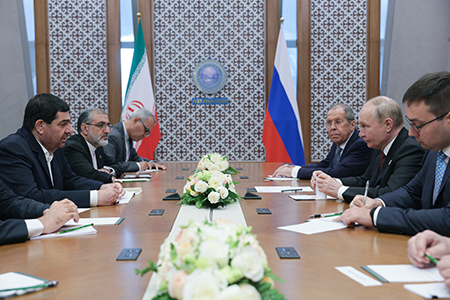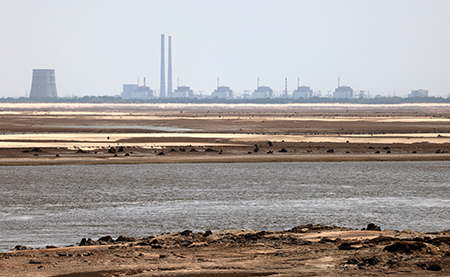"Though we have acheived progress, our work is not over. That is why I support the mission of the Arms Control Association. It is, quite simply, the most effective and important organization working in the field today."
Russia and Its Nuclear Modernization Plans
September 2024
By Amy J. Nelson
How the candidates should handle Russia and its nuclear modernization program centers on two important questions: What should U.S. nuclear policy be in light of sovereign states that break from the status quo, particularly with respect to the nuclear order? How can the United States best prepare for nuclear eventualities resulting from Russia’s modernization plan, given that Russia no longer is constrained by the Intermediate-Range Nuclear Forces (INF) Treaty and perhaps even the New Strategic Arms Reduction Treaty (New START)?

Russia’s aggressive actions over the past decade signal a departure from the major powers’ norms of behavior, which historically have included good-faith participation in international institutions and promotion of a rules-based order. Russia’s revisionist and risk-seeking tendencies include incursions into sovereign states, exerting undue influence over its neighbors, and claiming territory in states that flank NATO. Its behavior tracks an equally troubling course for nuclear norms. In the mid-2010s, Russia violated the INF Treaty, which banned all ground-launched ballistic and cruise missiles with ranges between 500 and 5,500 kilometers, with its 9M729 missile. Russia denied the violation and refused to provide transparency into the nuclear weapons system or to modify it in any way. The United States eventually withdrew from the treaty because of Russian noncompliance.1
In 2022, Russia suspended U.S. inspections under New START after the West imposed sanctions in response to Russia’s full-scale invasion of Ukraine.2 In February 2023, Russia escalated its noncompliance by suspending participation in New START more broadly, halting inspections and data sharing. It stated, however, that it would still respect the treaty’s limits. The United States responded by halting its own obligations under the treaty, including ceasing to share certain data on missile launches and to participate in inspections.3
Additionally, Russia has been accused of providing nuclear assistance and technologies to Iran and North Korea and blocking or weakening nuclear nonproliferation language in UN Security Council resolutions. Russia also has occupied the Zaporizhzhia Nuclear Power Plant in Ukraine, using the facility as a nuclear shield, violating norms concerning the protection of civilian infrastructure in wartime and increasing the risk of a nuclear accident.4

Russia’s most risky violation of nuclear norms may be its threatened nuclear use. This has included statements that Russia might use nuclear weapons if its own security is threatened and signals that it might be willing to escalate its war in Ukraine from a conventional conflict to a nuclear one.5 The United States has condemned such rhetoric.6
Meanwhile, Russia continues its military modernization plans, including for its nuclear forces. Although aimed at optimizing conventional forces for quick campaigns and decisive outcomes, these plans also involve the development of novel strategic weapons, including nuclear-powered cruise missiles, nuclear-powered “torpedoes,” and a hypersonic boost-glide system. These destabilizing systems are designed to evade U.S. missile defenses and complicate traditional deterrence calculations.7
Such developments highlight shortcomings with and challenges for U.S. nuclear policy. Russia’s saber-rattling underscores the paradox of possessing nuclear weapons for deterrence purposes, which requires signaling to an adversary a willingness to use them, but then balking at threats associated with their use. Because disarmament is not feasible in the near term, the United States must work with the four other main nuclear-weapon states to redefine the obligation of responsible nuclear powers to uphold deterrence norms.
Further, Russia is pursuing its exotic nuclear systems with no formal Comprehensive Test Ban Treaty (CTBT) in place, only an informal moratorium that is weakening. Russia signed the treaty in 1996, ratified it in 2000, then withdrew ratification in 2023. The United States signed the treaty in 1996 but never ratified. Ratifying the CTBT could prove an important tool in constraining Russia’s development of novel nuclear weapons.
ENDNOTES
1. Shannon Bugos, “U.S. Completes INF Treaty Withdrawal,” Arms Control Today, September 2019, https://www.armscontrol.org/act/2019-09/news/us-completes-inf-treaty-withdrawal.
2. Shannon Bugos, “Russia Further Pauses New START Inspections,” Arms Control Today, September 2022, https://www.armscontrol.org/act/2022-09/news/russia-further-pauses-new-start-inspections.
3. Bureau of Arms Control, Deterrence, and Stability, U.S. Department of State, “U.S. Countermeasures in Response to Russia’s Violations of the New START Treaty,” June 1, 2023, https://www.state.gov/u-s
-countermeasures-in-response-to-russias-violations-of-the-new-start-treaty/.
4. Amy J. Nelson and Chinon Norteman, “What to Do About the Zaporizhzhia Nuclear Power Plant,” Brookings: Order From Chaos blog, March 23, 2023, https://www.brookings.edu/articles/what-to-do-about-the-zaporizhzhia-nuclear-power-plant/.
5. Jim Sciutto, “Exclusive: U.S. Prepared ‘Rigorously’ for Potential Russian Nuclear Strike in Ukraine in Late 2022, Officials Say,” CNN, March 9, 2024, https://www.cnn.com/2024/03/09/politics/us-prepared-rigorously-potential-russian-nuclear-strike-ukraine/index.html.
6. “Remarks by National Security Advisor Jake Sullivan for the Arms Control Association (ACA) Annual Forum,” The White House, June 2, 2023, https://www.whitehouse.gov/briefing-room/speeches-remarks/2023/06/02/remarks-by-national-security-advisor-jake-sullivan-for-the-arms-control-association-aca-annual-forum/.
7. Matthew Kroenig, Mark Massa, and Christian Trotti, “Russia’s Exotic Nuclear Weapons and Implications for the United States and NATO,” Atlantic Council Issue Brief, March 2020, https://www.atlanticcouncil.org/wp-content/uploads/2020/07/Russias-Exotic-Nuclear-Weapons.pdf.
Amy J. Nelson is a visiting fellow in the International Security Program at New America and an adjunct faculty at Georgetown University.
